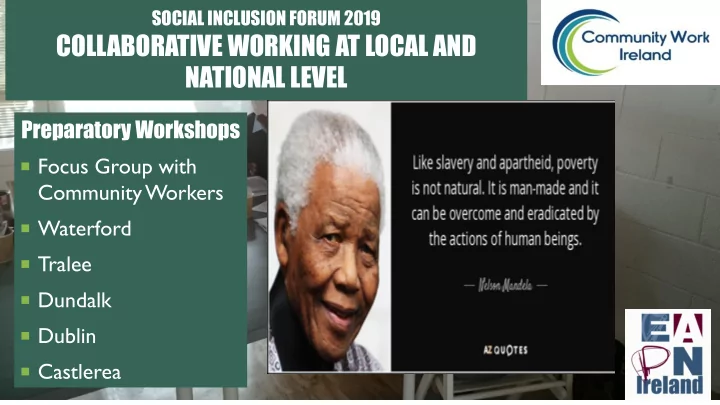

SOCIAL INCLUSION FORUM 2019 COLLABORATIVE WORKING AT LOCAL AND NATIONAL LEVEL Preparatory Workshops Focus Group with Community Workers Waterford Tralee Dundalk Dublin Castlerea
POVERTY LEVELS Poverty levels continue to be unacceptably high Structural causes – not just symptoms Cost of living – esp. housing Poverty & Deprivation 35 A consistency of inequality 30 25 20 Many groups and 15 10 communities including 5 0 2004 2005 2006 2007 2008 2009 2010 2011 2012 2013 2014 2015 2016 2017 Travellers and other At Risk of Poverty Rate (%) 19.4 18.3 17 16.5 14.4 14.1 14.7 16 16.5 15.2 16.3 16.3 16.2 15.7 Deprivation Rate (%) 14.2 14.8 14 11.8 13.7 17.1 22.6 24.5 26.9 30.5 28.9 25.4 21 18.8 minorities not featured Consistent Poverty Rate (%) 6.8 7 6.5 5.1 4.2 5.5 6.3 6.9 8.2 9 8.3 8.5 8.2 6.7 At Risk of Poverty Rate (%) Deprivation Rate (%) Consistent Poverty Rate (%) “Poverty is hidden and dispersed – because people and families are getting HAP, they often live in areas that are not included in SICAP or other target areas”
STRATEGY & MEASUREMENT “People are really struggling but it is not always visible. The Resource “How many years are we waiting for Allocation Model and the targets the new National Action Plan? Is it that are set preclude us from really going to be presented without working with people that really any real consultation?” need it. There are a large number of refugees living in [name of area] but the Index indicates this is an affluent area – work we do there is What is essential is commitment to consultation not counted by the system” and an understanding that consultation makes for better policy-making. It is too late now for Deprivation measures need to be consultation on the National Strategy so what we updated and reflect new forms of need is a clear commitment to robust processes poverty, including exclusion and built into the implementation of the Strategy. lack of access to services, particularly in rural areas
IMPLEMENTATION & ACCOUNTABILITY Gaps in the implementation of policy Monitoring mechanisms for progress on poverty and social “How do we get the words on the pages of the inclusion need to be reviewed and given additional status. National Report into action? Do these forums work? Does anything change?” Efforts to re-establish the network of social inclusion officers in each government department was welcomed SIF – re-established as a robust mechanism for accountability on progress.
Welcome the shift to collaborative ways of working Mechanisms such as the Local Community Development Committees not reaching full potential – failing to get the government departments and agencies to collaborate on locally shared targets in COLLABORATIVE many areas WORKING AT LOCAL & Competitive tendering and target setting for the NATIONAL Social Inclusion Community Activation Programme LEVELS and other programmes have been damaging
“Community development has been decimated – we COMMUNITY DEVELOPMENT really need autonomous infrastructure and programmes if we are Community Development is critical in serious about collaboration and making addressing poverty and social exclusion a real impact on poverty Decimated over the past number of and social exclusion” years by policy decisions and funding cuts
GETTING MORE FROM DATA Data and information sources currently used is problematic for a number of reasons: Main sources of data, such as SILC, fail to capture minorities, including Travellers; Over-reliance on quantitative data - fails to reflect the lived experience and the impact of poverty on people and communities; The over-reliance on income as a measure of poverty fails to reflect more comprehensive notions of wellbeing; There is a myriad of data being collected at local, regional and national levels by community organisations and government agencies but there are few attempts to collate the information being gathered.
SOCIAL INCLUSION AND PEOPLE WITH DISABILITIES Added cost of disability Disproportionate number of people with disabilities in poverty Measures needed to address barriers - clamp-down on behaviour that inhibits people with disabilities - Access to employment - still very difficult and the ‘reasonable’ accommodation requirement on employers does not go far enough Greater measures required to support entrepreneurship for people with disabilities Need greater awareness of disabilities amongst employers.
HOUSING & ACCOMMODATION AND SOCIAL INCLUSION Social Housing Traveller Accommodation Homelessness Women in refuge not counted HAP payments – top-up
THE ROLE OF EMPLOYERS IN SOCIAL INCLUSION NEGATIVE ATTITUDE OF MANY ISSUES FOR (WORKING) PARENTS ON EMPLOYERS TO MANY INCLUDING LOW INCOME MINORITIES AND THOSE WITH DISABILITIES
TRAVELLER HEALTH & WELLBEING Issues have been well rehearsed Action based on Social Determinants of Health that link social, economic and cultural conditions Traveller health and wellbeing cannot be addressed in isolation of the wide range of issues being faced Traveller voice essential – need for an autonomous Traveller organisation in each area
BREXIT Fear of the unknown – return of the Border and associated issues Already having an effect including a chilling effect Supports to enterprise need to be extended to community
OTHER ISSUES Rural Isolation Refugees and Asylum Seekers Older People Carers
Recommend
More recommend